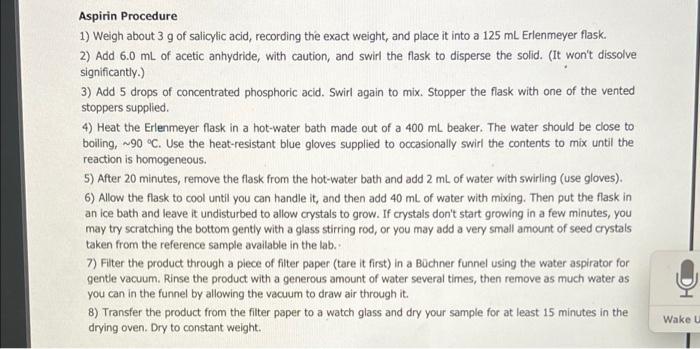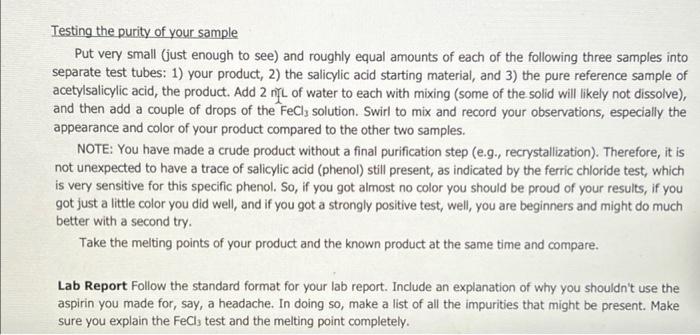Lab Report Follow the standard format for your lab report. Include an explanation of why you shouldn't use the aspirin you made for, say, a headache. In doing so, make a list of all the impurities that might be present. Make sure you explain the FeCl3 test and the melting point completely. Aspirin Procedure 1) Weigh about 3 g of salicylic acid, recording the exact weight, and place it into a 125 mL Erlenmeyer flask. 2) Add 6.0 mL of acetic anhydride, with caution, and swirl the flask to disperse the solid. (It won't dissolve significantly.) 3) Add 5 drops of concentrated phosphoric acid. Swirl again to mix. Stopper the flask with one of the vented stoppers supplied 4) Heat the Erlenmeyer flask in a hot-water bath made out of a 400 ml beaker. The water should be close to boiling, ~90 C. Use the heat-resistant blue gloves supplied to occasionally swirl the contents to mix until the reaction is homogeneous. 5) After 20 minutes, remove the flask from the hot-water bath and add 2 mL of water with swirling (use gloves). 6) Allow the flask to cool until you can handle it, and then add 40 mL of water with mixing. Then put the flask in an ice bath and leave it undisturbed to allow crystals to grow. If crystals don't start growing in a few minutes, you may try scratching the bottom gently with a glass stirring rod, or you may add a very small amount of seed crystals taken from the reference sample available in the lab. 7) Filter the product through a piece of filter paper (tare it first) In a Bchner funnel using the water aspirator for gentle vacuum. Rinse the product with a generous amount of water several times, then remove as much water as you can in the funnel by allowing the vacuum to draw air through it. 8) Transfer the product from the filter paper to a watch glass and dry your sample for at least 15 minutes in the drying oven. Dry to constant weight Wake u Testing the purity of your sample Put very small (just enough to see) and roughly equal amounts of each of the following three samples into separate test tubes: 1) your product, 2) the salicylic acid starting material, and 3) the pure reference sample of acetylsalicylic acid, the product. Add 2 nl of water to each with mixing (some of the solid will likely not dissolve), and then add a couple of drops of the FeCl solution. Swirl to mix and record your observations, especially the appearance and color of your product compared to the other two samples. NOTE: You have made a crude product without a final purification step (e.g., recrystallization). Therefore, it is not unexpected to have a trace of salicylic acid (phenol) still present, as indicated by the ferric chloride test, which is very sensitive for this specific phenol. So, if you got almost no color you should be proud of your results, if you got just a little color you did well, and if you got a strongly positive test, well, you are beginners and might do much better with a second try. Take the melting points of your product and the known product at the same time and compare. Lab Report Follow the standard format for your lab report. Include an explanation of why you shouldn't use the aspirin you made for, say, a headache. In doing so, make a list of all the impurities that might be present. Make sure you explain the FeCl2 test and the melting point completely












